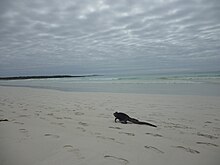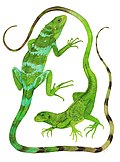Marine iguana
| Marine iguana | |
|---|---|

| |
| Scientific classification | |
| Kingdom: | |
| Phylum: | |
| Class: | |
| Order: | |
| Suborder: | |
| Family: | |
| Genus: | Amblyrhynchus
|
| Species: | A. cristatus
|
| Binomial name | |
| Amblyrhynchus cristatus (Bell, 1825)
| |
| Subspecies | |
|
7 ssp.; see text | |

| |
The marine iguana (Amblyrhynchus cristatus) is an iguana found only on the Galápagos Islands that has the ability, unique among modern lizards, to live and forage in the sea, making it a marine reptile. The iguana can dive over 9 m (30 ft) into the water. It has spread to all the islands in the archipelago, and is sometimes called the Galápagos marine iguana. It mainly lives on the rocky Galápagos shore to warm from the comparably cold water, but can also be spotted in marshes and mangrove beaches.

Subspecies
Listed alphabetically.[2]
- A. c. albemarlensis Eibl-Eibesfeldt, 1962 – Isabela Island
- A. c. cristatus Bell, 1825 – Fernandina Island
- A. c. hassi Eibl-Eibesfeldt, 1962 – Santa Cruz Island
- A. c. mertensi Eibl-Eibesfeldt, 1962 – San Cristóbal and Santiago Islands
- A. c. nanus Garman, 1892 – Genovesa Island
- A. c. sielmanni Eibl-Eibesfeldt, 1962 – Pinta Island
-
A. c. albemarlensis
-
A. c. cristatus
-
A. c. hassi
-
A. c. mertensi
-
A. c. nanus
Anatomy


On his visit to the islands, despite making extensive observations on the creatures, Charles Darwin was revolted by the animals' appearance, writing:
- The black Lava rocks on the beach are frequented by large (2–3 ft [60–90 cm]), disgusting clumsy Lizards. They are as black as the porous rocks over which they crawl & seek their prey from the Sea. I call them 'imps of darkness'. They assuredly well become the land they inhabit.[3]
Amblyrhynchus cristatus is not always black; the young have a lighter coloured dorsal stripe, and some adult specimens are grey, and adult males vary in colour with the season. Dark tones allow the lizards to rapidly absorb heat to minimize the period of lethargy after emerging from the water.
Breeding-season adult males on the southern islands (Española, Floreana and nearby islets) are the most colourful and will acquire red and teal-green colours, while on Santa Cruz they are brick red and black, and on Fernandina they are brick red and dull greenish.
Another difference between the iguanas is size, which is different depending on the island the individual iguana inhabits. The iguanas living on the islands of Fernandina and Isabela (named for the famous rulers of Spain) are the largest found anywhere in the Galápagos. On the other end of the spectrum, the smallest iguanas are found on the island on Genovesa.
Adult males are up to 1.7 metres (5.6 ft) long, females 0.6–1 metre (2.0–3.3 ft), males weigh up to 12 kilograms (26 lb).
The marine iguana lacks agility on land but is a graceful swimmer. Its laterally flattened tail and spiky dorsal fins aid in propulsion, while its long, sharp claws allow it to hold onto rocks in strong currents.
Its diet consists of seaweed and algae. A flat snout and sharp teeth enable it to browse on algae growing on rocks. A nasal gland filters its blood for excess salt ingested while eating, which is expelled through the nostrils, often leaving white patches of salt on its face.
Behavioural ecology
As an ectothermic animal, the marine iguana can spend only a limited time in cold water diving for algae. Afterwards it basks in the sun to warm up. Until it can do so it is unable to move effectively, making it vulnerable to predation. Marine iguanas become highly defensive when in this state, biting at potential threats. During the breeding season males assemble large harems of females, which they guard aggressively against rivals. Fights sometime occur but are generally harmless; they will bob their heads as a threat and if the other suitor responds, both will thrust their heads together until one backs away.[4]
Marine iguanas have been found to change their size to adapt to varying food conditions. During an El Niño cycle in which food diminished for two years, some were found to decrease their length by as much as 20%. When food supply returned to normal, iguana size followed suit. It is speculated that the bones of the iguanas actually shorten as shrinkage of connective tissue could only account for a 10% change in length.[5] Research suggests iguanas secrete a stress hormone that induces decreased skeletal size.[6]
El Niño conditions also increase mortality among larger-bodied iguanas, which take longer after foraging trips to warm up and digest algae consumed than smaller-bodied iguanas. Thus the latter are able to make more feeding excursions in a given day.[7]
Evolutionary history
Researchers theorize that land iguanas and marine iguanas evolved from a common ancestor since arriving on the islands from South America, presumably by rafting.[8][9] It is thought that the ancestral species inhabited a part of the volcanic archipelago that is now submerged. The two species remain mutually fertile, and occasionally hybridize where their ranges overlap. The subspecies are identifiable by their distinct colorations, for example the Espanola race is more red while the Santiago iguanas are more so green.[4]
Taxonomy and etymology
Its generic name, Amblyrhynchus, is a combination of two Greek words, Ambly- from Amblus (ἀμβλυ) meaning "blunt" and rhynchus (ρυγχος) meaning "snout". Its specific name is the Latin word cristatus meaning "crested," and refers to the low crest of spines along the animal's back.
Amblyrhynchus is a monotypic genus, having only one species, Amblyrhynchus cristatus.
Conservation
The marine iguana is completely protected under the laws of Ecuador, and is listed under CITES Appendix II. Decreases in food supply due to El Niño cause periodic major declines in population. The species is threatened by predation by introduced species such as cats and dogs, which prey particularly upon its young. Due to the lack of natural predators in the area, they are defenseless against the new species and most of the population are matured.[4] The total population size is unknown, but is, according to IUCN, at least 50,000, and estimates from the Charles Darwin Research Station are in the hundreds of thousands.

Gallery
-
A colourful adult male iguana.
-
Marine iguanas, Galápagos Islands
-
Marine iguanas, Galápagos Islands
-
Marine iguanas, Fernandina, Galápagos Islands
-
Marine iguana at Tortuga Bay beach on Santa Cruz Island, Galápagos
-
Highly colored individual of the venustissimus subspecies found on Española Island
See also
Bibliography
- Rothman, Robert, Marine Iguana Galapagos Pages. Rochester Institute of Technology. Retrieved 19 April 2009.
References
- ^ Template:IUCN2012.1
- ^ Amblyrhynchus cristatus, Reptile Database
- ^ Darwin, Charles (2001). Charles Darwin's Beagle Diary. London: Cambridge University Press. p. 494. ISBN 0-521-00317-2.
- ^ a b c "Marine Iguanas". Retrieved 20 December 2013.
- ^ M, Wikelski (Jan 6, 2000). "Marine iguanas shrink to survive El Niño". Nature. 403 (6765): 37–8. doi:10.1038/47396. PMID 10638740.
{{cite journal}}: Unknown parameter|coauthors=ignored (|author=suggested) (help) - ^ Wikelski, M. (2005). Evolution of body size in Galápagos marine iguanas. Proceedings: Biological Sciences, 272(1576), 1985-1993
- ^ Wikelski, M. (2005). Evolution of body size in Galapagos marine iguanas. Proceedings: Biological Sciences, 272(1576), 1985-1993
- ^ Rassman K, Tautz D, Trillmich F, Gliddon C (1997), The micro - evolution of the Galápagos marine iguana Amblyrhynchus cristatus assessed by nuclear and mitochondrial genetic analysis.: Molecular Ecology 6:437–452
- ^ Marine Iguana: marinebio.org. Retrieved 16 August 2006.













